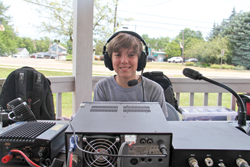Amateur radio festival connects hams around the world
by Martin McConnell
Northern Summit County’s PrepNet Radio Group took part in the American Radio Relay League’s annual “Field Day” event for amateur ham radio from June 25-26. PrepNet was one of over 40,000 ham stations that particiapted in the event, which took place across North America.
Paul Buescher is a long-time member of PrepNet and a main fixture of ham radio in Summit County. He mentioned that in addition to being a continent-wide, show-and-tell exhibit, the Field Day event is his opportunity to share his lifelong passion for radio with others.
“I started when I was a kid. I’ve been on the air for 52 years now,” Buescher said. “I started through high school. … I took a test and got my first license in 1970, and it’s been going on ever since.”
While simple in design and easy to use, ham radios still allow operators to communicate with people across the globe. According to a press release from PrepNet about Field Day, “The [Northern Summit County] group operated continuously for twenty-hours and established clear two-way communications with 41 states and 6 countries including: all the East, South and West coast states, and the island nation of Cyprus located in the Mediterranean Sea, south of Turkey.
“They also contacted the Canary Islands off the coast of Morocco, the country of Slovenia and the Maritimes (New Brunswick) on the east coast of Canada.”
Participants in the relay were: Steve Hendrix, W8HXS, Sagamore Hills; Greg Hendrix, KE8PYE, Sagamore Hills; Dan Kuches, KE8KES, Northfield Center; AJ Kuches, KE8OMG, Northfield Center; Paul Buescher, N8HHG, Northfield Center; Zenon Bartosik, W8ZB, Northfield Center; Mike Lester, KD8VHA, Sagamore Hills; Rich James, N8FIL, Northfield Center; Jeff Kunkel, KD8JPQ, Sagamore Hills; and Ken Wood, Hudson.
Buescher noted that ham radio is especially useful in case of emergencies, such as hurricanes, blackouts or an electromagnetic pulse blast, which is a burst of electromagnetic energy that disrupts communication with electronic devices, like cell phones.
“The radios are about the size of a bread box,” Buescher said. “If you have a big emergency somewhere, or a disaster, and all other forms of communication are down, amateur radio operators always come through.”
Setting up a mobile or permanent station is where the ease of use really shines through for ham radio. Buescher mentioned that simply hooking up an antenna to a pickup truck can serve as a ham station that can connect nationwide.
“A lot of people think in ham radio, you have to have these big towers up at your house and everything,” Buescher said. “I have a tower here, but it’s not for this type of ham radio, it’s for higher frequencies. My main antenna, for talking all around the world, is basically an aluminum pipe that sticks 25 feet up from the ground.”
The local PrepNet Radio Group has existed since 2006, and has participated in Field Days since the event’s inception in 2009. As a hobby, ham radio attracts people of all ages, and PrepNet is no different.
“Our youngest member is a resident here in Northfield Center, he’s 14 years old,” Buescher said. “He got his license when he was 13. It goes all the way to [over 80] years old.”
Buescher stressed ham radio’s use as a public service, and even as a backup communications network for emergency services such as ambulances and fire departments.
“Let’s say we had one of those power outages that we had back in ’03,” Buescher said. “Any time that someone would need help. Say all the police and fire radios went out. We have equipment that can help them out.”
Buescher urged anyone with even a slight interest in ham radio to look into the hobby through the ARRL’s website, arrl.org.
“Really, a good idea is to contact a ham in [your] area, and go from there,” Buescher said. “You’ll find that most ham operators are very friendly, and more than willing to help someone that’s interested.” ∞

